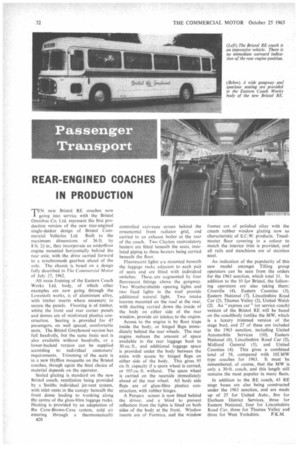REAR-ENGINED COACHES IN PRODUCTION
Page 34

If you've noticed an error in this article please click here to report it so we can fix it.
.TEN new Bristol RE coaches now
going into service with the Bristol Omnibus Co. Ltd. represent the first production version of the new rear-engined single-decker design of Bristol Commercial Vehicles Ltd. Built to the maximum dimensions of 36 ft. by 8 ft. 2+ in., they incorporate an underfloor engine mounted horizontally beh:nd the rear axle, with the drive carried forward to a synchromesh gearbox ahead of the axle. The chassis is based on a design fully described in The Commercial Motor of July 27, 1962.
All main framing of the Eastern Coach Works Ltd. body, of which other examples are now going through the Lowestoft works, is of aluminium alloy, with timber inserts where necessary to secure the panels. Flooring is of timber, whilst the front and rear corner panels and domes are of reinforced plastics construction. Seating is ,provided for 47 passengers, on well spaced, comfortable seats. The Bristol Greyhound version has full headrolls, but the same basic seat is also available without headrolls, or a lower-backed version can be supplied according to individual customers' requirements. Trimming of the seats is in a new Hyfflon moquette on the Bristol coaches, though again the final choice of material depends on the operator.
Sealed glazing is standard on the new Bristol coach, ventilation being provided by a Smiths individual jet-vent system. with inlet vents in the canopy beneath the front dome leading to trunking along the centre of the glass-fibre luggage racks. Heating is provided by an adaptation of the Cave-Brown-Cave system, cold air entering through a thermostatically
R20
controlled vari-vane screen behind the ornamental front radiator grid, and carried to an exhaust boiler at the rear of the coach. Two Clayton recirculatory heaters are fitted beneath the seats, insulated piping to these heaters being carried beneath the floor.
Fluorescent lights are mounted beneath the luggage racks adjacent to each pair of seats and are fitted with individual switches. These,are augmented by four fluorescent fittings above the gangway. Two Weathershields opening lights and two fixed lights in the roof provide additional natural light. Two intake louvres mounted on the roc,f at the rear, with ducting carried down the inside of the body on either side of the rear window, provide air intakes to the engine.
Access to the engine is by floor traps inside the body, or hinged flaps immediately behind the rear wheels. The rear engine reduces the amount of space available in the rear luggage boot to 30 cu. ft., and additional 'luggage space is provided under the body between the axles with access by hinged flaps on either side of the body. This gives 95 cu. ft. capacity if a spare wheel is carried, or 105 cu. ft. without. The spare wheel is carried on the nearside immediately ahead of the rear wheel. All body side flaps are of glass-fibre plastics construction, with rubber hinges.
A Perspex screen is now fitted behind the driver, and a blind to prevent reflection from the lights is fitted on both sides of the body at the front. Window inserts are of Formica, and the window frames are of polished alloy with the cream rubber window glazing now so characteristic of E.C.W. products. Treadmaster floor covering in a colour to match the interior trim is provided, and all rails and stanchions are of stainless steel.
An indication of the popularity of this new model amongst Tilling group operators can be seen from the orders for the 1963 sanction, which total 31. In addition to the 10 for Bristol, the following operators arc also taking them: Crosville (4), Eastern Counties (3), Eastern National (7), Lincolnshire Road Car (2), Thames Valley (2), United Welsh (2). An "express car" (or service coach) version of the Bristol RE will be based on the coachbody (unlike the MW, which is a luxury trimmed version of the stage bus), and 27 of these are included in the 1963 sanction, including United Automobile Services (10), Eastern National (8), Lincolnshire Road Car (2), Midland General (3), and United Counties (4). This gives a combined total of 58, compared with 102 MW type coaches for 1963. It must be remembered, of course, that the MW is only a 30-ft. coach, and this length still remains the most popular in many fleets.
In addition to the RE coach, 43 RE stage buses are also being constructed under the 1963 sanction, and are made up of 25 for United Auto., five for Durham District Services, three for Eastern National, four for Lincolnshire Road Car, three for Thames Valley and three for West Yorkshire. F.K.M.




























































































